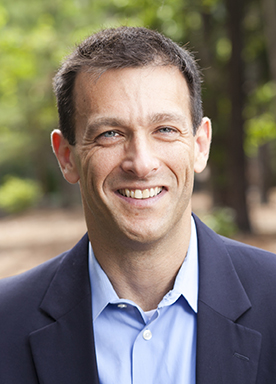 In an essay that appeared Nov. 1 in the New England Journal of Medicine, Professor Barak Richman offers several examples of promising emerging technologies that can improve health care delivery: an iPhone feature that facilitates patient access to medical records, a wearable device for monitoring vital signs and detecting the onset of illness, and artificial-intelligence algorithms that help patients stick to their care plans. But, he noted, a major obstacle for these and other tech-assisted diagnostic and therapeutic tools is that they will meet resistance from traditional health care regulations.
In an essay that appeared Nov. 1 in the New England Journal of Medicine, Professor Barak Richman offers several examples of promising emerging technologies that can improve health care delivery: an iPhone feature that facilitates patient access to medical records, a wearable device for monitoring vital signs and detecting the onset of illness, and artificial-intelligence algorithms that help patients stick to their care plans. But, he noted, a major obstacle for these and other tech-assisted diagnostic and therapeutic tools is that they will meet resistance from traditional health care regulations.
“As new products and systems emerge, the health policy community faces a basic question: If these technologies are at odds with current regulations, does that reveal a shortcoming in the technologies or a shortcoming in the law? Does it make sense that Alexa can remind me when I need to purchase more cereal, but not when I need to take my insulin?”
The problem, writes Richman, the Edgar P. and Elizabeth C. Bartlett Professor of Law and Professor of Business Administration, stems from a mismatch: Current regulations were designed for a system that posits health care services being delivered by a (human) doctor to a patient in person, while in the digital age, algorithms, artificial intelligence, massive data-storage systems, and multiple telecommunications devices all come into play.
“Of course, digital health care interventions and services must meet acceptable quality standards,” he writes, noting the role of regulators at the Food and Drug Administration, which oversees devices, and the Centers for Medicare and Medicaid Services, which regulates electronic health systems. “But assessing them effectively will mean discarding traditional guidelines and inherited legal categories, instead recognizing the needs they aim to meet, the realistic dangers they introduce, and the new models of care they offer.”
Among other areas where Richman spots a mismatch: the fee-for-service payment model that places providers at the core of health care delivery, whereas mobile technology makes the patient the primary point of contact; the medical malpractice regime that focuses on physician failure as opposed to algorithmic or systemic inadequacy; and state board licensure for the practice of medicine when “the hallmark of digital medicine is the blurring of boundaries between providers and products.”
New technologies, he writes, “are stretching health care regulatory categories beyond recognition. A better approach might be to change the law to meet the needs of the public and the industry, rather than the other way around. … [I]f the law is used with foresight, it can help enable Americans to benefit from the promise of new digital technologies.”





